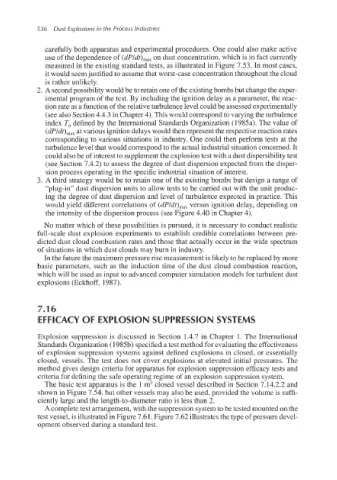Page 569 - Dust Explosions in the Process Industries
P. 569
536 Dust Explosions in the Process Industries
carefully both apparatus and experimental procedures. One could also make active
use of the dependence of (dpldt),, on dust concentration, which is in fact currently
measured in the existing standard tests, as illustrated in Figure 7.53. In most cases,
it would seemjustified to assume that worst-case concentrationthroughout the cloud
is rather unlikely.
2. A secondpossibility would be to retain one of the existing bombs but change the exper-
imental program of the test. By including the ignition delay as a parameter, the reac-
tion rate as a function of the relativeturbulencelevel could be assessed experimentally
(see also Section4.4.3 in Chapter 4). This would correspond to varying the turbulence
index T, defined by the International Standards Organization (1985a). The value of
(dP/dt),,, at various ignition delays would then represent the respectivereaction rates
corresponding to various situations in industry. One could then perform tests at the
turbulence level that would correspond to the actual industrial situation concerned. It
could also be of interestto supplementthe explosiontest with a dust dispersibilitytest
(see Section 7.4.2) to assess the degree of dust dispersion expected from the disper-
sion process operating in the specific industrial situation of interest.
3. A third strategy would be to retain one of the existing bombs but design a range of
“plug-in” dust dispersion units to allow tests to be carried out with the unit produc-
ing the degree of dust dispersion and level of turbulence expected in practice. This
would yield different correlations of (dPldt),, versus ignition delay, depending on
the intensity of the dispersion process (see Figure 4.40 in Chapter 4).
No matter which of these possibilities is pursued, it is necessary to conduct realistic
full-scale dust explosion experiments to establish credible correlations between pre-
dicted dust cloud combustion rates and those that actually occur in the wide spectrum
of situations in which dust clouds may burn in industry.
In the future the maximum pressure rise measurementis likely to be replaced by more
basic parameters, such as the induction time of the dust cloud combustion reaction,
which will be used as input to advanced computer simulation models for turbulent dust
explosions (Eckhoff, 1987).
7.16
EFFICACY OF EXPLOSION SUPPRESSION SYSTEMS
Explosion suppression is discussed in Section 1.4.7 in Chapter 1. The International
Standards Organization(1985b) specified a test method for evaluating the effectiveness
of explosion suppression systems against defined explosions in closed, or essentially
closed, vessels. The test does not cover explosions at elevated initial pressures. The
method gives design criteria for apparatus for explosion suppression efficacy tests and
criteria for defining the safe operating regime of an explosion suppression system.
The basic test apparatus is the 1 m3 closed vessel described in Section 7.14.2.2 and
shown in Figure 7.54, but other vessels may also be used, provided the volume is suffi-
ciently large and the length-to-diameterratio is less than 2.
A complete test arrangement,with the suppression system to be tested mounted on the
test vessel, is illustratedin Figure 7.61. Figure 7.62 illustratesthe type of pressure devel-
opment observed during a standard test.

